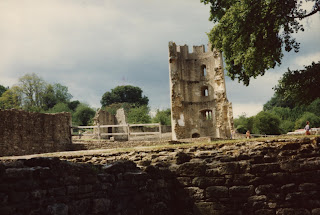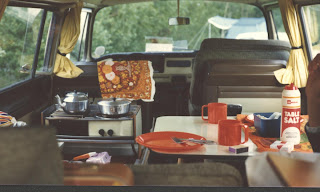We had spent the previous three weeks getting to London, finding our way around, buying a van and setting it up ready for camping. 35 years later we still own some of the things we bought, and use one knife every day - it was definitely a good buy! Now it was time to go exploring and try out our van setup around a bit of England, so that we could easily buy more things / change things while still in a country where we could understand and be understood most of the time.
So on Tuesday 3 June 1975 we set off for the South of England. What with stopping to buy fuel and tools, and then taking many wrong turns, it took us a long time to get out of London but eventually we got onto the M4 going as far as
Newbury, where we had lunch. Moving on, we looked for a camping ground in Marlborough without success, and so it was my time to drive -
ARRRRGH! Eventually we found a camping ground at
Rowde and cooked our first meal in the van. This camping ground was not good preparation for the future: it had free hot showers and our van was parked among trees beside a lake - delightful.
The English countryside that we had driven through was exactly like the picture books - for some reason I had not expected that. The roads were odd to us kiwis though: very narrow, but miles from anywhere there was still curb and channelling, and bus stops even though there appeared to be no houses nearby.
Wednesday saw us driving through Bradford-On-Avon, a lovely old town with winding streets - a few months later we would be somewhat more blase about such things but at this stage we were fresh from a country where 'historic' was something from before 1900! So a huge, stone, tithe barn dating from 955AD blew us away. And from there on the day just got more and more amazing for us colonials. We arrived our first castle. I never got sick of castles. Farleigh
Hungerford Castle (1370AD) was a ruined castle, but somehow that emphasised to me just how much older Britain is than New Zealand.
Next stop: Bath, which despite modernisation, retained its old time feel. We walked through the streets looking in windows of fascinating but expensive antique shops until we reached the centre of the town, where Bath Abbey dominated the central square.
The Roman Baths were awesome: to think of that plumbing being done such a long time before. In the same complex and the pump rooms where we were able to 'take the waters', but they were not nice, tasting as they did of slightly salty warm water.
Up the hill were the Assembly Rooms, which now housed a museum of costumes right up to the current t
ime. It was fascinating, but as I looked at the clothes it was with mixed feeling: regret at the passing of an age of elegance and of perfection of manufacture; but also of thankfulness that we don't have to spend all that time making our clothes. The poor people who had to sit over that intricate work: their eyesight must have failed at a very young age.
We stopped for the night at
Watchet (don't you love those names?) at a huge but fortunately near empty camp by the sea. From our position on a hill we could see across to Wales, but it was not a nice view as it seemed to consist entirely of festering factories spluttering forth huge clouds of black smoke.
The 5th June was a day of very windy roads and incredibly steep hills. The hills were not very long but so steep that there were 'escape routes' on the corners for all those who could not follow instructions like 'engage in low gear'.
We stopped at our first 'live' castle,
Dunster Castle, where the family were still in residence, with us visitors helping pay some of the cost of upkeep. We were blown away by the magnificence of its staircase and leather wall hangings. When we arrived we were among about 25 people waiting for it to open. A couple of minutes before the hour a man dressed like a butler emerged from the castle and walked across to the old gate tower and was followed by a lot of people jostling to be first in. They quickly emerged, embarrassed, as the man led the way out and set up a sign outside saying 'Men's Toilet'.
Dunster Castle - Cally on seat
On Friday 6th we drove on around Cornwall. We went through St Ives but didn't stop to visit the man with seven wives as the place was full of cars, policemen, road works and diversions. In one very narrow country road we, and a truck, had to wait for two other road users to back up to a wider part of the road - a man and his dog! We stopped at
Penzance for shopping and on to Land's End for lunch. It was terribly windy, but otherwise a cloudless, sunny day. The sky was full of vapour trails, bringing home to us how much air traffic there was between Britain and Europe.
Land's End
Cornwall was not as pretty as Devon. It was bleak and bare with brown rolling hills and strong winds. The farms didn't have fences, but rather, mile upon mile of stone walls instead. The house and farm buildings were also made of stone, to keep out the wind and rain, with little thought of beauty, although it did have a bleak sort of charm.
St. Michael's Mount - and Mac
St. Micheal's Mount - and our Kombi
And the wonderful names: we spent the night at
Lostwithiel.









































